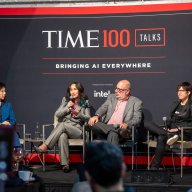e como são bastante infantilóides vão esperar que seja o estado e o seu orçamento a resolver... ou os bancos falirem que tb fica bem
Like most Americans, I like to think of myself as an individual—but a week ago I walked out into a parking lot to find five cars identical in make, model, year, and color to my own. I was glad I remembered my license plate number, and that my key fob would (hopefully) only unlock the correct vehicle.
A few days later I found myself in a grocery checkout line, skimming through yet another article in which the writer touted the wonders of “artificial intelligence” and fretted hazily over whether we are nearing the point when AI will be able to produce novels, films, and other creative work, effectively replacing us. When I looked up and over to other people in the line, half of them wore the same shoe brand as me.
The truth is that there is no such thing as “artificial intelligence.” ChatGPT, Midjourney, and the like are not conscious, intelligent minds. As sophisticated as they are, they are only language and image models fed with the results of human innovation scraped and stolen from the internet. Having analyzed what we have written or depicted before, these programs then statistically anticipate what the next most likely word in a sentence should be, or what color the next pixel in an image should be.
Because so much of our day-to-day behavior, including the things we write and say, is as predictable as the make, model, year, and color of my car or the brand of my shoes, these tools are effective when we need regurgitation of the commonplace. They are useful for making lists, organizing notes, creating the kind of linguistic filler we skim over when reading a website, and writing passable, if bland, essays on many basic topics (which is why they have inspired so much hand wringing in academia). The visual tools can generate a number of mashups, from derivative but serviceable commercial logos to work in the stereotyped style of individual artists to, in a recent example I saw floating around, a pretty realistic illustration of an otter using Wi-Fi on a plane. Simply put: AI thrives when our need for originality is low and our demand for mediocrity is high.
Read More: Pausing AI Developments Isn't Enough. We Need to Shut it All Down
More From TIME
The problem for AI is that creative work is not predictable. It is not about statistical likelihood or simply mashing up the familiar—it is about leaps in logic and counterintuitive juxtapositions. It is about the unique experience of the individual, and seeking to do what has never been done before. It is about the least predictable next word or pixel. So the danger is not that AI programs will write the next great novel or create the next great painting, successfully replacing human inventiveness: they never will. The greater danger is that they won’t need to create great writing or art.
Because they cannot truly innovate, everything that predictive language and image models will produce will be a sequel to what came before: not an original idea, but a mash-up of our old tropes, repackaged for our consumption. This was already a dominant tendency in our commercial industries—to simply take what has been done before, tweak it a little, rebrand it, and call it new. As a result, AI will fill the world with grindingly average texts, passable but derivative illustration and video, and unoriginal but functional new product designs.
The real danger to human creativity that these tools represent is the mechanization of human innovation. Relying on these tools will discourage us from looking beyond what has been done before, and further reduce innovation into no more than imitative remixing. Businesses and corporations assert that mechanization will benefit both the worker and the consumer. It’ll save time and make things more efficient. Think, for instance, back to FORD’s “five dollar workday”—a profit sharing program that gave a five-dollar salary for employees working eight-hour days. The idea behind it, the Ford Sociological Department hoped, was that it would supposedly motivate employees to create efficient work patterns and revolutionize work. How it actually played out was very different. Ford replaced skilled craftsmen with unskilled labor doing repetitive, monotonous work. John A. Fitch, a journalist of the time, described how “it may be fine to see an automobile come through that door every 20 seconds—but you don’t see them if your job is to start the nuts on the threads. You haven’t time. There are always more bolts to be capped.” Mechanization demands a replaceable worker—a person who performs a single task and who can be trained to do it in minutes. This was one of the first innovations of mass production. As a result, today’s worker is less skilled, lower paid—and far less valued.
But a topic less explored is that mechanization also demands a replaceable consumer: a target to be manipulated into purchasing low-quality products they do not need—and that they did not actually want. In the end, mechanization’s real innovation is in manipulating consumer demand: creating a complacent buyer with reduced expectations of quality. Once you’ve done that, you can sell them a “good enough” widget. You have to create a person willing to accept “good enough.” You have to create a person willing to spend a pain-inducing amount of money on upgrading to an only marginally better phone. What is really being manufactured is us—our perceived needs, our attitudes toward what is good, our willingness to settle for “good enough.”
That’s always been the way: the long-distance truck tomatoes sold in American supermarkets, for instance, are grainy, and oftentimes flavorless, but you won’t ever know how bad they are until you bite into an heirloom tomato and understand what you are missing. Similarly, the companies that own nearly all of our media have devoted billions of dollars to retelling stale stories instead of the thousands of new ones out there, but we’ll never know what could have been, because all they will put their money behind is The Avengers again—forever.
There is an inevitable argument, of course, that AI tools somehow extend creativity, allowing someone without creative skills to make stories or pictures. That they can help turn anyone into a writer or an artist. This is not the case: using these tools to write a story or make a picture does not make their user a writer or an artist any more than my assembling an IKEA bookshelf makes me a carpenter. The end product will be serviceable, but it won’t be more than that.
Nor is the issue an economic one: the costs for corporations and even small companies of paying actual writers and artists and designers are minimal compared to virtually any of their other expenditures. The writers who recently went on strike in Hollywood, for example, earn a pittance compared to what the executives and even mid-level managers in their companies rake in. While it may be true that, according to Salary.com, a writer/producer at HBO makes north of $100,000 a year, the reality is that writing jobs are unstable, so the real year-on-year numbers are significantly lower than that. Mark Mohan, the creator of the Netflix show Everything Sucks! has detailed how Hollywood writers find themselves trapped in a "chaotic system, where the pay and pay structure don't match up to the work being done and the demands it puts [on] your life” and how writers face long periods of unemployment, scraping by on exploitative gig work. HBO’s CEO, on the other hand, made almost 40 million dollars last year. Disney makes $27 million.
Can we recognize the loss of creativity caused by AI as it’s happening? Do we know there is less that is truly new in the world, and fewer avenues for personal expression? Many of us may not. Absence of choice is hard to sense, and mechanization’s real innovation is in creating a complacent buyer with reduced expectations. Once you’ve done that, you can sell them whatever you want. What is being mechanized by AI is our tastes—our ability to discern quality (or originality) at all.





